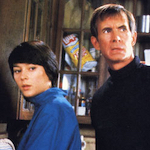 June 3, 1983
June 3, 1983
The summer of ’83 saw the release of many blockbuster sequels. There was the big space one, a comic book one, one or more James Bonds, also a PORKY’S, a PINK PANTHER, and a SMOKEY AND THE BANDIT. I suppose you could say there were two horror sequels, both continuing beloved classics from Universal Pictures. One of those involved a shark. The other was riskier. These people had the audacity to make a sequel to a hallowed decades-old classic, the mother of modern horror.
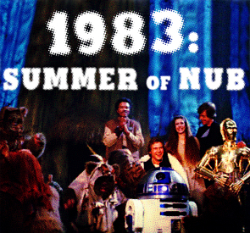 I reviewed PSYCHO II back in 2009, and I think that piece is a good summary of what the movie’s like. Even back then I got that it’s not just better than you’d think or surprisingly good, it’s a genuine classic among horror sequels. I didn’t see the movie until quite a few years after it came out, but having grown up in the ‘80s it used to be impossible to think of anything made in that period as worthy of a classic black and white film from 1960, directed by the iconic Alfred Hitchcock. You have your recency bias, but you also think of contemporary stuff as inherently lesser than the classics. In some of my really old reviews you can see me shit talking what I saw as the cheesy ‘80s, not understanding the reverence people younger than me were starting to have for that era. Now I get it, though. I just needed more distance.
I reviewed PSYCHO II back in 2009, and I think that piece is a good summary of what the movie’s like. Even back then I got that it’s not just better than you’d think or surprisingly good, it’s a genuine classic among horror sequels. I didn’t see the movie until quite a few years after it came out, but having grown up in the ‘80s it used to be impossible to think of anything made in that period as worthy of a classic black and white film from 1960, directed by the iconic Alfred Hitchcock. You have your recency bias, but you also think of contemporary stuff as inherently lesser than the classics. In some of my really old reviews you can see me shit talking what I saw as the cheesy ‘80s, not understanding the reverence people younger than me were starting to have for that era. Now I get it, though. I just needed more distance.
What’s so impressive about PSYCHO II is how well director Richard Franklin (in his followup to the excellent ROAD GAMES) threads the needle of being true to the original but also to the times. It would’ve been disastrous if it didn’t feel anything like the original, but at the same time the story is about time having passed, so it couldn’t be entirely a throwback. I love how he opens with parts of the famous shower scene, then during the shot of the house with Norman’s voice crying out to Mother, it transitions from black and white to color. It’s a way to start off on a pure Hitchcock note and yet it’s also ‘80s slasher sequel 101 – it exactly mirrors the opening of FRIDAY THE 13TH 3D, released the previous August. That one starts with footage from part 2, but at the end of it switches from 2D to 3D. (There’s another FRIDAY THE 13TH sequel parallel at the end of this one: the heroine will dress up as Norman’s mother to try to trick him, just like Ginny did to Jason in FRIDAY THE 13TH PART 2.)
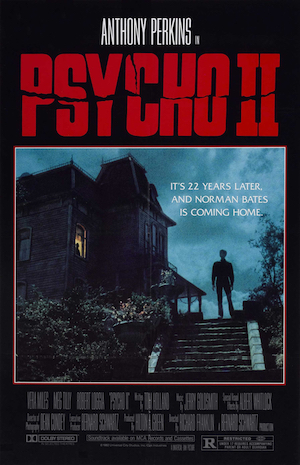 But there was less than a year between the releases of FRIDAY THE 13TH and its part 2. This one took 23 years. There have been longer outside of horror – THE COLOR OF MONEY was 25 years after THE HUSTLER, TRON: LEGACY was 28 years after TRON, THE ODD COUPLE II was 30 years after THE ODD COUPLE, BLADE RUNNER 2049 was 35 years after BLADE RUNNER, TOP GUN: MAVERICK was 36 years after TOP GUN.
But there was less than a year between the releases of FRIDAY THE 13TH and its part 2. This one took 23 years. There have been longer outside of horror – THE COLOR OF MONEY was 25 years after THE HUSTLER, TRON: LEGACY was 28 years after TRON, THE ODD COUPLE II was 30 years after THE ODD COUPLE, BLADE RUNNER 2049 was 35 years after BLADE RUNNER, TOP GUN: MAVERICK was 36 years after TOP GUN.
The time gap for PSYCHO and PSYCHO II is the same as if they came out with CHERRY FALLS 2 this summer. Obviously it had more it had to live up to, but if you can imagine a director now who loved CHERRY FALLS when they were younger, that was PSYCHO to Richard Franklin. When he was a film student at USC, he was so into Hitchcock he arranged a screening of ROPE, got to talk to him on the phone, convinced him to come do a lecture, became friends with him and even visited the sets of TOPAZ and FAMILY PLOT. He made screenwriter Tom Holland (THE BEAST WITHIN, CLASS OF 1984) study every Hitchcock movie in detail to prepare. The pacing, shot compositions (cinematographer: Dean Cundey, HALLOWEEN, THE FOG), the score by Jerry Goldsmith (who had been friends with the late Bernard Herrmann) and the acting style of Vera Miles (returning as Lila Loomis, formerly Crane) are all classically Hitchock-esque, but Franklin isn’t too precious to include ‘80s touches like some teenagers sneaking into the cellar of the Bates house “smoking dope, messin’ around,” or a couple flashes of up-to-date gore. I did find some reviews objecting to the latter, which is frankly asinine unless they’ve been lying to us all this time about how unheard of and envelope pushing the violence of PSYCHO was in its day. The most gruesome shot of the sequel is below and it’s very cool, but your average decent slasher movie of the era had at least 4 or 5 parts like that. Come on, uptight critics of 40 years ago. I’m calling you fuckers out.
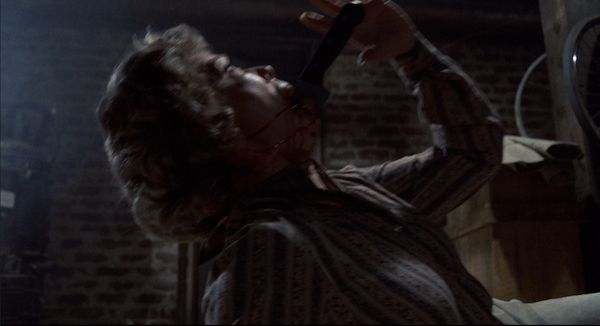
The distance between the two eras is one of the things that makes the story effective. Norman has been declared sane again and released (against Lila’s outraged protests in court), thrown right back into his old life at the house and the motel. He’s got Dr. Raymond (Robert Loggia, THE NINTH CONFIGURATION) looking out for him, but no social workers, thanks to budget cuts. (Ain’t that the truth?) He only has his job as assistant to the cook at a nearby diner to help him assimilate with other living human beings. Usually in a sequel we imagine what has been going on in the character’s life since last time, but Norman has only been in a mental hospital – our first day back on the Bates property is his too.
He hasn’t really matured past the already stunted young man he was before incarceration, but he can’t hide that he’s older. The age difference between 51 year old Perkins and born-the-same-year-as-PSYCHO Meg Tilly as his waitress friend Mary creates extra discomfort around his apparent attraction to her, but it’s also a plot point (spoiler: she’s secretly Lila’s daughter, born soon after the murders). They’re both basically playing games of chicken, or having dares with themselves, for the whole movie. Norman invites this young woman to the motel, puts her in cabin 1, knows she’s taking a shower, is sincerely not trying to do anything wrong but knows he’s tempting himself to repeat his crimes, and also knows what this would look like to anybody else. For her part, Mary keeps putting herself in these vulnerable situations with this guy she just met, knowing it’s creepy, seemingly telling herself “it’s probly fine,” and later as she finds out more about his past having to weigh her sympathy for him and belief in his recovery against the danger he poses. There’s a good chemistry and potent tension between the two actors, though I’ve read that during filming Tilly greatly offended Perkins by asking a crew member why everyone was making such a big deal about him, and he tried to get her replaced.
The feeling of being back in the same creepy house from the first movie is potent, so I wasn’t surprised to read that the set was still standing from the original film and that they found some of the original props and decorations. Virginnia Gregg also returns as the voice of Mrs. Bates when he hears it. So it’s just like being home again. He’s eating off her china plates, using cleaning products that must’ve been sitting there partially used for decades. Reminds me of the things I’d find in the backs of my parents’ cupboards sometimes.
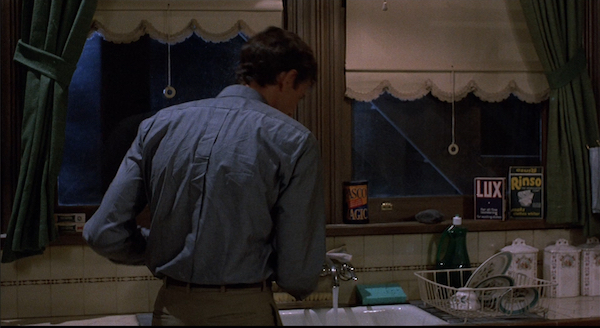
Even setting aside the horror movie stuff, there’s something sad and haunting about this man having lived such an isolated life with only his mother, now coming back and it’s still very much her place. He’s lonely and afraid and very awkwardly convinces Mary to stay for a white bread sandwich and glass of milk. Seems nice enough, though.
 Holland’s script is full of many great twists, and just like I said in my first review I never quite remember all of them on a rewatch, so it keeps me in suspense. The biggest, smartest source of tension is that we want to like Norman just like we did before we knew he was a killer the first time we saw the first one. We want him to succeed in his rehabilitation. It’s very uncomfortable when he’s confronted by actual victim Lila – there’s nothing he can say. But when an asshole like Toomey (Dennis Franz, BLOW OUT), the hotel manager he fires, starts harassing him and calling him names – it’s like, come on man, leave him alone. And then Norman starts finding notes and getting phone calls and it’s anyone’s guess whether someone’s messing with him or he’s hallucinating again. But either way he starts insisting to people what’s happening and becoming flustered as he realizes that it’s making him look like, you know… a psycho.
Holland’s script is full of many great twists, and just like I said in my first review I never quite remember all of them on a rewatch, so it keeps me in suspense. The biggest, smartest source of tension is that we want to like Norman just like we did before we knew he was a killer the first time we saw the first one. We want him to succeed in his rehabilitation. It’s very uncomfortable when he’s confronted by actual victim Lila – there’s nothing he can say. But when an asshole like Toomey (Dennis Franz, BLOW OUT), the hotel manager he fires, starts harassing him and calling him names – it’s like, come on man, leave him alone. And then Norman starts finding notes and getting phone calls and it’s anyone’s guess whether someone’s messing with him or he’s hallucinating again. But either way he starts insisting to people what’s happening and becoming flustered as he realizes that it’s making him look like, you know… a psycho.
I like how the sheriff (Hugh Gillin, BILLY JACK GOES TO WASHINGTON) gives Norman a fair chance, even seems to sense that people are messing with him, and tries to protect him. Knowing that Mary’s in over her head, whatever reason she has for hanging out with him, he tries to freak her out by telling her more about Norman’s past.
“You know why Norman doesn’t come down here, don’t you?” he asks her after having to investigate the fruit cellar.
“No, I don’t.”
“He used to keep his mother’s corpse down here. Stole it from the grave. Talked to himself in her voice, answering in his own. What do you think of that?”
“It’s horrible.”
“That’s right, it was.”
Continuing Norman’s story allows for great moments like that, or when they’re nice enough to dig up his mother’s grave just to convince him she’s really dead and it’s just kinda like okay, yeah, you guys were right, sorry about that. I wish we got a better look at the faces of the poor guys who had to do the work. They’re just standing there, holding the lid up. Doing their job. Should’ve gotten a tip.

The most fair complaint I’ve seen about PSYCHO II is that (SPOILER) Lila, a protagonist and sister of a victim in the first film, has become an antagonist. If we side with Norman we really dislike her for going to extreme lengths to mess with his head and get him locked up again. But I don’t know – she thinks that the system has failed her, and I suppose she’s correct, because we’ve got two more sequels coming. He’s a danger to society. Better she take justice into her own hands with some Scooby-doo shit than try to shoot him, or burn him alive like they did to Freddy Krueger. And I like the conflict between her and and her daughter as you first realize that Mary has been deceiving Norman (which explains many of the puzzling choices she’s made) and then that she really does feel sorry for him, starts covering for him with the police, and tries to convince him that he’s not losing it when he thinks he is. You have to start wondering wait a minute, there are people really being killed, that can’t be Lila, can it? When Mary confronts Lila about some of the things going on and she clearly doesn’t know about them, we realize something even crazier is going on.
Great suspense moments: The stuff involving the peephole in the bathroom. Mary notices a flash of light in the mirror while doing her lashes, discovers the hole. Later she’s on the other side and sees an eye looking through at her, but she calls to Norman and he’s still downstairs. Terrifying!
Perkins’ performance in the first one is monumental, and not a trick that can be repeated, but he gets a whole other set of layers to stack here – the vulnerable man alone in a place of trauma, the apologetic nice guy trying not to make everything weird, the boy scout outraged to find drugs in a motel room, the guy getting angry that no one else sees what’s being done to him, the guy starting to lose it and accept the false reality. It’s all good stuff. A great sequel.
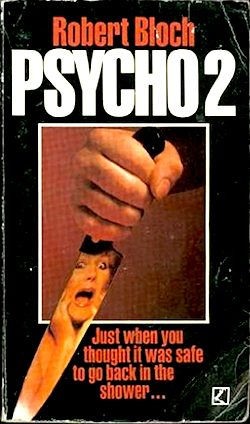 Like the original PSYCHO, the sequel started with a book by Robert Bloch, but in this case it wasn’t an adaptation. Trying to capitalize on and/or satirize the slasher boom born from the movie of his book, Bloch wrote a sequel in which Norman escapes the asylum disguised as a nun, then kills and commits necrophilia with another nun, and picks up a hitchhiker to kill and burn as a way of faking his death. Meanwhile, a movie is being made about Norman’s life, and people involved in it start getting killed. But also the director of the movie is a psycho who plans to rape and murder the actress playing Marion while rehearsing the shower scene. Instead he gets stabbed in the shower. Not by Norman, though. It turns out the hitchhiker Norman picked up was also a killer, and actually killed Norman and burned his body to fake his death. And Norman’s psychiatrist was so bummed that he didn’t get to cure him and get famous that he developed a split personality and started killing the people doing the movie. (This is all from Wikipedia, I have not read it, so I can’t say if it’s good or bad. I have my suspicions though.)
Like the original PSYCHO, the sequel started with a book by Robert Bloch, but in this case it wasn’t an adaptation. Trying to capitalize on and/or satirize the slasher boom born from the movie of his book, Bloch wrote a sequel in which Norman escapes the asylum disguised as a nun, then kills and commits necrophilia with another nun, and picks up a hitchhiker to kill and burn as a way of faking his death. Meanwhile, a movie is being made about Norman’s life, and people involved in it start getting killed. But also the director of the movie is a psycho who plans to rape and murder the actress playing Marion while rehearsing the shower scene. Instead he gets stabbed in the shower. Not by Norman, though. It turns out the hitchhiker Norman picked up was also a killer, and actually killed Norman and burned his body to fake his death. And Norman’s psychiatrist was so bummed that he didn’t get to cure him and get famous that he developed a split personality and started killing the people doing the movie. (This is all from Wikipedia, I have not read it, so I can’t say if it’s good or bad. I have my suspicions though.)
According to Bloch, he sent the manuscript to Universal in case they wanted to make a movie out of it, and they thought it was so terrible they tried to convince him not to publish it. But also they were inspired to hire someone to write, like, a good PSYCHO II to do as a made-for-cable movie.
Alfred Hitchcock had died in 1980, but his daughter Patricia felt he would’ve approved of this sequel idea, which convinced original PSYCHO assistant director Hilton A. Green to accept an offer to produce. But it wasn’t a sure bet that Perkins, who had resented being typecast as Norman Bates, would want to do it. Christopher Walken is reportedly one of the people they considered as a replacement – that would’ve been weird. But the script won Perkins over, and they let him work with Holland on added character moments such as the sandwich scene. With his participation it grew into a bigger deal, and a theatrical release.
I think the movie is more respected now than it was then, but it wasn’t entirely rejected or condemned as blasphemy. Variety called it “an impressive, 23-years-after followup,” saying that Franklin “deftly keeps the suspense and tension on high” and “Perkins is very entertaining, whether stammering over the pronunciation of ‘cutlery’ or misleading the audience in both directions as to his relative sanity.” Roger Ebert was a little less effusive, but said that “if you can accept this 1983 movie on its own terms” then “it does have its moments, and it’s better than your average, run-of-the-mill slasher movie.” But Jack Kroll of Newsweek wrote, “You don’t have to be a Hitchcock idolater to see that this dumb, dull, plodding, pseudo-camp bore is a callous, commercial parasite,” and Gary Arnold of The Washington Post called it “a travesty masquerading as a sequel” and weirdly compared it to “a wacky-tacky pilot film for TV’s first situation slasher comedy,” suggesting several possible titles that must’ve seemed funny at the time.
PSYCHO II made $34.7 million at the box office, but that’s good – it’s almost 7 times the budget. PSYCHO III followed three years later, directed by Perkins himself, and pretty good for a third time around, though this one’s much better. A goofy TV spinoff called BATES MOTEL got a pilot that ran as a TV movie in 1987, but it ignored the events of the sequels, and only had glimpses of Norman, played by Perkins’ stunt double Kurt Paul. Perkins did return for the 1990 sequel/prequel PSYCHO IV: THE BEGINNING, but was reportedly unhappy to not be directing and instead be bossed around by CRITTERS 2 director Mick Garris. I don’t personally like that one, though Henry Thomas is very good as the young Norman. That one did go straight to cable, bringing the sequels full circle, I guess.
For his contribution to the summer of ’83 movie season, Bloch wrote the novelization of TWILIGHT ZONE: THE MOVIE.
Signs o’ the times: Battlezone and Ms. Pac-Man at the diner.



























June 1st, 2023 at 11:30 am
Another drive-in viewing (looking back, I seemed to go to the drive-in a lot in ’83). I’d seen the original on TV, but didn’t consider it to be some sacred cow (I probably didn’t even know that other people considered it a sacred cow), so I took it totally on it’s own terms and thought it was a ton fun. It wasn’t until like 00-01 did I see it again on cable, and was a little surprised to see it was actually a good movie too (as I wasn’t the most discerning 10-year-old critic), and that Perkins is really, really good in it.